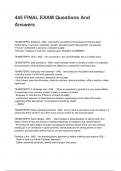445 FINAL EXAM Questions And
Answers
TEAMSTEPPS: feedback - ANS Information provided for the purpose of improve team
performance. It is timely, respectful, specific, directed toward improvement, considerate.
*Formal:* scheduled in advance, evaluative quality
*Informal:* happens in real time, ongoing basis, HUDDLE or DEBRIEF!
TEAMSTEPPS: CUS - ANS I am concerned, I am uncomfortable, this is a safety issue.
TEAMSTEPPS: task assistance - ANS team members foster a climate in which it is expected
that assistance will be actively sought and offered as a method for reducing errors.
TEAMSTEPPS: advocacy and assertion - ANS -advocating for the patient and asserting a
corrective action in a firm and respectful manner.
-Invoked when team members viewpoints do not align.
- Use 5 steps: open the discussion, state the concern, state the problem, offer a solution, obtain
agreement.
TEAMSTEPPS: 2 challenge rule - ANS · When an assertion is ignored it is your responsibility
to assertively voice concern at least 2 times to ensure it is heard
· Empower to 'stop the line' if there is a breach of safety
· constructive approach of describing the situation, expressing concern about the action,
suggesting other alternatives, consequences should be stated
--- 'DESC'
TEAMSTEPPS: before starting procedure - ANS prior to start of procedure such as putting in a
central line there needs to be a time out to ensure correct pt, site and procedure
TEAMSTEPPS: Alarm fatigue - ANS · Alarm fatigue is desensitization to alarms when you
listen to them all day and results in delayed responses to situations and missed alarms.
· Prevention of alarm fatigue includes managing the physical layout of the unit, like avoiding
locating pt.'s on ventilators in close proximity, devise protocols for setting alarms on best
practices, and education staff on how to set and respond to alarms.
Palliative Care - ANS *an interdisciplinary approach to relieve suffering and improve QOL*
· Goals of care is a Family Centered Approach
· Gather advanced directives, identify and change Code status
,· Hold a patient/family meeting early in the ICU stay
· Outline the steps to be taken to accomplish goals
· Communicate care plan
· Use an interdisciplinary approach to decision making
· If patient lacks capacity, or legal rep, a guardian should be appointed
*always want to regard the pt wishes-guardian will be appointed if pt is critically ill to recall
wishes*
*example of when to consult would be if chronic pain can't be controlled, not able to sleep or
walk ad seems withdrawn*
pacemaker cells: SA Node - ANS 60-100 bpm
sinus rhythm
atrial rate
primary pacemaker of the heart
pacemaker cells: AV Node - ANS 40-60 bpm
junctional heart rate
pacemaker cells: purkinji fibers - ANS 20-40 bpm
ventricular heart rate
sinus rythme lengths - ANS P: < .20 seconds (5 little boxes--longer would be heart block)
PRI: 0.12-0.20 seconds
QRS: <.12
QTI: < .40
asystole symtpoms - ANS this is a flat line:
no heartbeat, no resp, no pulse
H's and T's:
hypovolemia, hypoxia, hydrogen ions (acidosis), hypo/hyperkalemia hypothermia
tension pneumo, tamponade, toxins, thrombosis
asystole nursing care - ANS check pt FIRST: pulse and leads
if flat line:
call for help and perform CPR
DO NOT SHOCK
heart is stopped so need to restart with ACLS
administer epinephrine
PAC/PJC - ANS junctional dysrhythmia:
extra beat--early P wave before some QRS
*P waves may be inverted or absent*
due to hypoxemia, stimulants (caffeine, coke), MI, CHF, dig toxicity
, treatment: none if infrequent. treat cause if frequent-reduce stimulants, corrections of
hypokalemia
Vtach symptoms - ANS frequent PVC increases risk for vtach
dizziness
SOB
lightheadedness
feeling as if heart is racing--palpitations
chest pain
Vtach nursing care-with pulse - ANS #1 is check the patient
synchronized cardioversion
amiodarone
procainamide
vtach nursing care--no pulse - ANS *defibriallte*
CPR
SCREAM:
shock
CPR
rhythm check
epinephrine
amiodarone (antiarrythmic)
magnesium sulfate--IV push
heart block symptoms - ANS irregular R-R: atrium and ventricles are not working together
1st: long PR interval
2nd Mobitz 1: PRI becomes further apart
2nd Mobitz 2: multiple P for every QRS-QRS becomes further apart or drops
3rd: PRI absent, multiple P for every QRS, wide QRS
3rd: atrial rate of 60-100
caused by hypoxemia, MI, ischemia, electrolyte imbalance, rheumatic fever
heart block nursing care - ANS 1st: monitor
2nd: monitor-give O2 if needed
3rd: EMERGENCY
call for help
CPR/ACLS
-give O2
Bradycardia symptoms - ANS HR < 50
syncope: fainting
dizziness/lightheaded
fatigue




